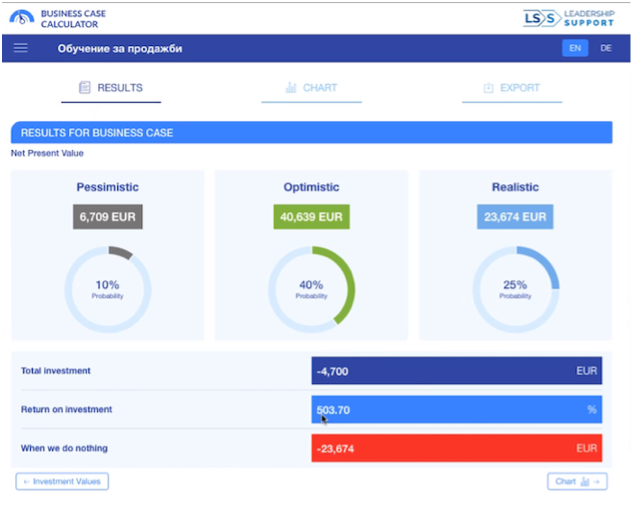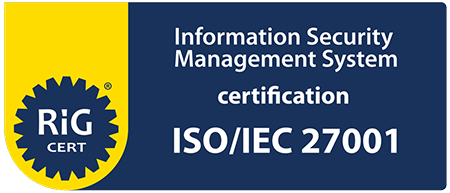Have you ever proposed a great HR project (training, program, or survey) that aims to increase employee engagement or productivity, but you have received a total rejection from the company's top management?
If your answer is YES, then we have the following question for you:
Suppose you want to conduct an innovative two-day training of a team of 12 salespeople for selling a new company service that will be marketed for 12 months. Inspired by your idea, you decide to present it to senior management. In response to the excellently delivered advantages of such a training, you get the reaction: "Our salespeople are highly skilled and experienced, and they know the selling practices for offering a new service. So what will the company actually gain from another training? What will be the return on investment?".
If you can answer these queries with specific data, your success is most probably guaranteed. However, if you have difficulty with the calculations and don't know where to start, keep calm, we have a solution for you. We've dedicated Step 5 especially to you. There you'll also learn the answer to the dramatic ROI question related to our sales training example.
Just know that you are not alone. HR professionals often face tremendous difficulty getting funding for their employee-focused initiatives, retention, development, and wellbeing. Things become even more complicated when a crisis or unexpected change occurs, and HR spending is abruptly cut and moved to the 'non-priority' column. That's why we decided to share our experience on this topic, as many of our clients face the same problem, and it has a straightforward solution. So how can you deliver a compelling presentation to senior management to justify the investment in your HR project?
Step 1: Speak the language of your managers
Presenting a convincing business case to your senior management why the company needs your HR project is not such an overwhelming task - just explain it in their language. Keep in mind that your executives would want to make sure the company's future is secure, which means cutting costs, increasing efficiency and avoiding legal risks. They're looking for more profit, and to achieve that, they need the "right" (efficient, productive and loyal) employees who will commit to the company for the long term.
It is not surprising that senior executives only support and invest in HR-focused initiatives when they see them as a growth opportunity or additional benefits for the company. So, avoid using HR terminology because business leaders do not always adequately understand it. For example, HR professionals talk about "people", and business leaders talk about "human capital." And too often, human capital is the most expensive item in their budget. That's why maximising the return on investment in this area is critical. And our advice here is to pay special attention to it because achieving business goals, company profitability, and investor objectives are at the top of every executive's mind. Make sure that your project presentation is aligned with this.
Step 2: Prove that your HR initiative will have impact on the organisation's overall business performance
It’s a big claim, but one that can appeal to the logic of even the most frugal c-suiter. Show management how your project will help achieve the organization's business goals. For example, if the goal is to become more innovative in your sector, employee personal development initiatives will help build the mindset and behaviour necessary to achieve that goal.
Our advice is to be concise and clear. For busy business leaders, time means money, so don't be wordy in presenting the benefits of your initiative. The problem, the solution, a few statistics supporting your case, and that's all you practically need. If they want more detail, you can provide them with more information. Don't overwhelm leaders with data, inform them with analysis. Give them info on how your project will make or save them money.
Step 3: Money, money, money
Every HR project proposal has a specific monetary value. HR initiatives require time and resources to be effective and make a real difference. Unfortunately, the people who hold the company purse-strings, namely the CEO, CFO, and other senior leadership, tend to undervalue HR transformation. That's why one of the best ways to demonstrate the value of your HR initiative is to show its benefits through ROI. In addition, when building your business case, be sure to include figures for the project implementation costs, as well as the losses your company risks if it doesn't undertake anything. Demonstrating the real added value your project brings is critical to justifying the required funding.
A common HR mistake is not accounting for the time employees will need to devote to the initiative. Instead, be sure to provide a good estimate of the time and human resources required and explain how and why they are a good investment.
Step 4: Arm yourself with numbers
Your problems become the arguments you present to management in the form of figures. You derive your goals, and therefore also your arguments, from the challenges you face. Ask yourself, "How the project I am proposing will lead to improvements in the organization?" And remember, when arguing for change, you should always quantify the benefits of that change using concrete numbers.
Data is a key component of the HR professional's arsenal. To get management's attention and get them focused on the issues and projects that are important to you, approach them with creativity and present your ideas from their perspective.
Step 5: Useful technologies
Not everyone can or should know how to calculate ROI or the benefits a company would lose for not acting in a particular situation. That's why the LS-S Leadership Support team has developed the free web application Business Case Calculator to easily calculate the ROI of your HR and OD initiatives.
With the Business Case Calculator, we also did the calculations for our business case example about the innovative two-day training. In 4 easy steps, we filled in the required information, as follows:
1. Case description: name of the case (Sales training), why should this measure be taken referred to the organisational strategy (to increase sales rate), goal of the measure (to improve salespeople performance).
2. General information: number of participants (12 people), duration of the training (2 days), duration of impact (12 months), avarage annual salary per participant (15 000 EUR).
3. Expected benefit: benefit indicator (sales rate of the new product), expected number of units to be sold per quarter (600), value per unit (50 EUR), optimistic, pessimistic and realistic results of the measure/initiative implementation.
4. Investment values: daily cost per participant (100 EUR), additional costs (500 EUR).

Using the tool, we were able to calculate and visually illustrate the total investment (€4,700), its ROI value under pessimistic (10% = €6,709), optimistic (40% = €40,639) and realistic (25% = €23,674) scenario for the salse rates after the training, as well as other key metrics such as lost benefits (amounting to €23,674) if the initiative does not take place.
With the statistics and appealing graphics generated by the Business Case Calculator, you can easily and smartly justify your project costs.




